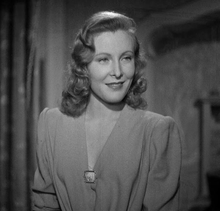Caterina Boratto
| Caterina Boratto | |
|---|---|
 Boratto in The Peddler and the Lady (1943) | |
| Born |
15 March 1915 Turin, Italy |
| Died |
14 September 2010 (aged 95) Rome, Italy |
| Occupation | Actress, singer |
| Years active | 1936–1993 |
| Spouse(s) | Armando Ceratto |
| Children | Marina Ceratto and Paolo Ceratto |
Caterina Boratto (15 March 1915 – 14 September 2010) was an Italian film actress. She appeared in 50 films between 1936 and 1993.
Life and career
Born in Turin, Boratto studied at the Musical Lyceum in her hometown with the purpuse of becoming a singer; noted by Guido Brignone, she made her debut in To Live, alongside Tito Schipa. Thanks to the film's success, she immediately became a star in the Telefoni Bianchi genre, and also got a seven years contract with Metro-Goldwyn-Mayer which eventually dissolved because of the World War II.[1][2]
In 1943 Boratto lost two brothers, the partisan Renato and the soldier Filiberto, killed in the massacre of the Acqui Division. In 1944, she married a doctor, Armando Ceratto, with whom she had two children. Except for a film in 1951, she basically retired from showbusiness for twenty years before accepting to play two key roles in 8½ and Juliet of the Spirits by Federico Fellini, who had knew her in the set of The Peddler and the Lady, where he had served as screenwriter. Starting from the second half of the 1960s, Boratto reprised appearing in films with some regularity, and from the late 1970s she also became very active on television, being cast in dozens of TV-series.[1][2]
Selected filmography

- To Live (1937)
- The Peddler and the Lady (1943)
- Measure for Measure (1943)
- Double Cross (1951)
- 8½ (1963)
- Juliet of the Spirits (1965)
- Me, Me, Me... and the Others (1966)
- Pardon, Are You For or Against? (1966)
- Don't Sting the Mosquito (1967)
- Pronto... c'è una certa Giuliana per te (1967)
- The Tiger and the Pussycat (1967)
- Danger: Diabolik (1968)
- The Lady of Monza (1969)
- Castle Keep (1969)
- Angeli senza paradiso (1970)
- The House of the Doves (1972)
- Hector the Mighty (1972)
- Story of a Cloistered Nun (1973)
- Summer to Remember (1974)
- Footprints on the Moon (1975)
- Salò, or the 120 Days of Sodom (1975)
- First Love (1978)
- The House by the Edge of the Lake (1979)
- Uno contro l'altro, praticamente amici (1981)
- That Night in Varennes (1982)
- Ehrengard (1982)
- Claretta (1984)
- Amici miei – Atto III (1985)
- 32 December (1988)
- Phantom of Death (1988)
- The Sleazy Uncle (1989)
- Once Upon a Crime (1991)
Further reading
- Paolo Ceratto; Franco Prono. Caterina Boratto: Una regalità completa. Daniela Piazza Editore, 2014. ISBN 9788898623280.
- Marina Ceratto. Caterina Boratto, la donna che visse tre volte. Edizioni Sabinae, 2016. ISBN 9788898623280.
References
- 1 2 Enrico Lancia, Roberto Poppi. "Boratto, Caterina". Dizionario del cinema italiano, Le Attrici. Gremese Editore, 2003. pp. 43–4. ISBN 888440214X.
- 1 2 Massimo Novelli (16 September 2010). "Addio all'algida Caterina diva dei Telefoni Bianchi". La Repubblica. Retrieved 27 November 2016.
External links
| Wikimedia Commons has media related to Caterina Boratto. |